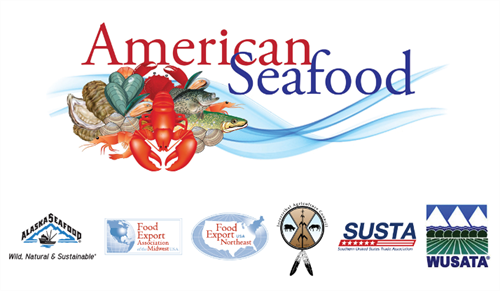Learn more about how Food Export-Northeast participated in the newly established Seafood Trade Task Force: a federal interagency body created by Presidential Executive Order to develop a strategy that provides the U.S. seafood industry with fair and reciprocal trade opportunities in foreign markets
Congratulations to the American lobster industry on the European Union (EU)’s decision to eliminate tariffs on live and frozen lobster from the U.S. Beginning two years ago, Maine’s lobster industry spearheaded efforts to recover sales lost after implementation of Canada’s Comprehensive and Economic Trade Agreement (CETA). Obtaining results took time and companies lost valuable sales in the interim, but we’re pleased that these efforts with the EU were finally successful.
Lost revenue due to market access issues is why the seafood industry has joined together and jumped at the chance to provide input into the newly established Seafood Trade Task Force: a federal interagency body created by Presidential Executive Order to develop a strategy that provides the US seafood industry with fair and reciprocal trade opportunities in foreign markets. As a major voice for industry tied to foreign market access issues, Food Export–Northeast plays an active role in keeping the industry informed, involving the sector when needed, and soliciting and consolidating feedback as issues emerge.
Food Export–Northeast coordinated a multi-organization response to the Task Force request for information to the comprehensive strategy they are tasked with developing. Working collaboratively with five organizations that promote seafood products in foreign markets, we developed a series of recommendations on how it can better support the seafood industry and level the playing field for export expansion. The partner organizations include:

The response focused on foreign market access and underscored the challenges American seafood industry professionals face when entering new overseas markets. While most foreign-harvested seafood can enter the US duty-free, American suppliers often face tariffs or access issues in foreign markets. A key point stressed in the letter centered around how important the seafood industry is to local economies: “exporting U.S.-origin seafood is a fundamental component of a profitable US seafood industry that provides essential economic support to many coastal communities.” Access issues for the United Kingdom, European Union (EU), Asian markets, and Russia were also outlined.
To further support fair and greater market diversification for the industry, we outlined that fisheries with high volumes must diversify their sales outlets in order to be successful. For example, there are species harvested from US waters that American consumers have little appetite or demand for, but overseas, these products could be sold successfully at a higher volume.
Conversations continue with these and other industry organizations across the country as well as with individual Task Force members. Opportunities for the seafood industry to be heard and understood across federal agencies do not happen often. We intend to do what we can to help Northeast US seafood exporters obtain fair and reciprocal trade access to markets worldwide.
About Food Export USA – Northeast
With its extensive programs and educational offerings, Food Export USA–Northeast (Food Export–Northeast) is recognized as the preeminent expert and cost-effective resource for Northeast seafood and agricultural suppliers looking to sell their products overseas. Founded in 1973, Food Export–Northeast is a non-profit organization that works collaboratively with its 10 member states’ agricultural promotion agencies from Connecticut, Delaware, Maine, Massachusetts, New Hampshire, New Jersey, New York, Pennsylvania, Rhode Island and Vermont, to facilitate trade between suppliers and worldwide importers and to promote the export of food, agricultural and seafood products from those states. Since its founding, the organization has helped Northeast seafood suppliers gain access to a broad range of export markets, supported overseas in-market educational and promotional programs and offers emerging suppliers access to funds to help grow their export business. The organization is funded through the Market Access Program (MAP), administered by the USDA’s Foreign Agricultural Service.
Learn more about us and what we do for the Northeast seafood industry here. Contact us.
Your Connection To Growth®
©2024 Food Export Association of the Midwest USA and Food Export USA–Northeast. All Rights Reserved.
Food Export–Midwest and Food Export–Northeast prohibits discrimination in all its programs and activities on the basis of race, color, national origin, religion, sex, gender identity (including gender expression), sexual orientation, disability, age, marital status, familial/parental status, income derived from a public assistance program, political beliefs, reprisal or retaliation for prior civil rights activity. (Not all bases apply to all programs.) Persons with disabilities who require reasonable accommodations or alternative means of communication for program information (e.g., Braille, large print, audiotape, American Sign Language, etc.) should contact us. Additionally, program information may be made available in languages other than English.
To file a program discrimination complaint, complete the USDA Program Discrimination Complaint Form, AD-3027, found online https://www.ascr.usda.gov/filing-program-discrimination-complaint-usda-customer.
Food Export–Midwest and Food Export–Northeast reserve the right to deny services to any firm or individual which, in the sole opinion of Food Export–Midwest and Food Export–Northeast, does not comply with FAS, MAP or Food Export–Midwest and Food Export–Northeast regulations or policies, or otherwise offer the best opportunity to achieve its mission of increasing food and agricultural exports. Submission of any false or misleading information may be grounds for rejection or subsequent revocation of any application or participation. Food Export–Midwest and Food Export–Northeast are equal opportunity employers and providers.
